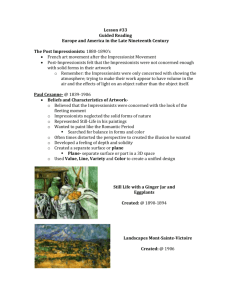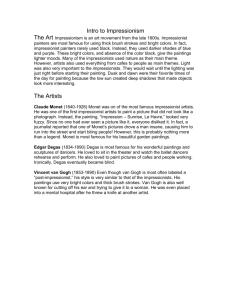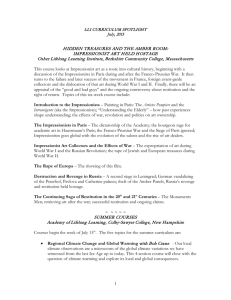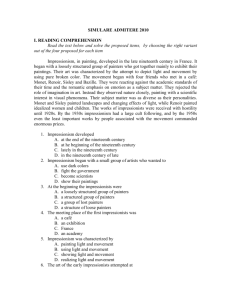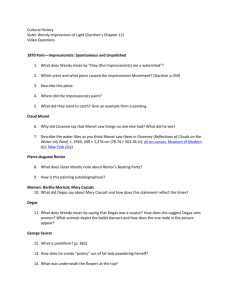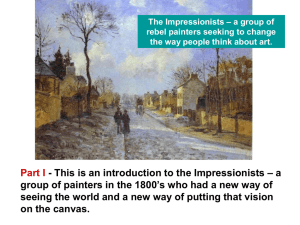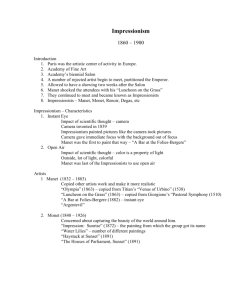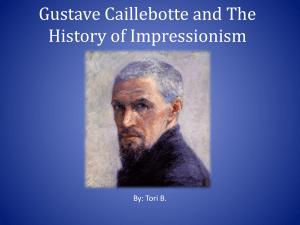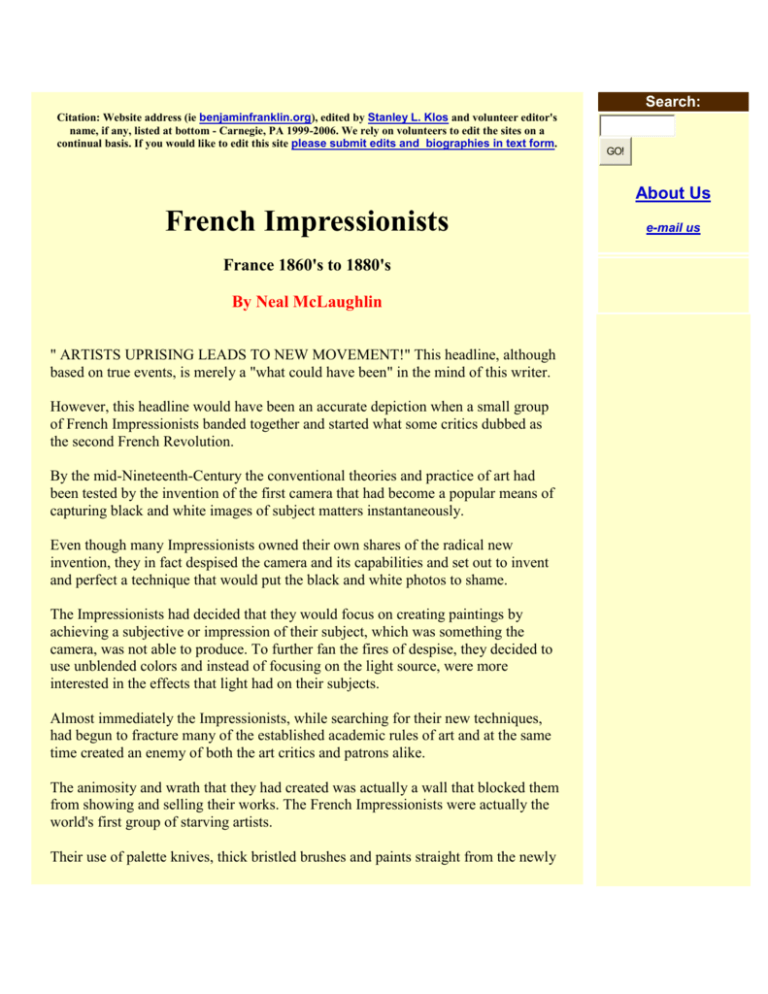
Search:
Citation: Website address (ie benjaminfranklin.org), edited by Stanley L. Klos and volunteer editor's
name, if any, listed at bottom - Carnegie, PA 1999-2006. We rely on volunteers to edit the sites on a
continual basis. If you would like to edit this site please submit edits and biographies in text form.
GO!
About Us
French Impressionists
France 1860's to 1880's
By Neal McLaughlin
" ARTISTS UPRISING LEADS TO NEW MOVEMENT!" This headline, although
based on true events, is merely a "what could have been" in the mind of this writer.
However, this headline would have been an accurate depiction when a small group
of French Impressionists banded together and started what some critics dubbed as
the second French Revolution.
By the mid-Nineteenth-Century the conventional theories and practice of art had
been tested by the invention of the first camera that had become a popular means of
capturing black and white images of subject matters instantaneously.
Even though many Impressionists owned their own shares of the radical new
invention, they in fact despised the camera and its capabilities and set out to invent
and perfect a technique that would put the black and white photos to shame.
The Impressionists had decided that they would focus on creating paintings by
achieving a subjective or impression of their subject, which was something the
camera, was not able to produce. To further fan the fires of despise, they decided to
use unblended colors and instead of focusing on the light source, were more
interested in the effects that light had on their subjects.
Almost immediately the Impressionists, while searching for their new techniques,
had begun to fracture many of the established academic rules of art and at the same
time created an enemy of both the art critics and patrons alike.
The animosity and wrath that they had created was actually a wall that blocked them
from showing and selling their works. The French Impressionists were actually the
world's first group of starving artists.
Their use of palette knives, thick bristled brushes and paints straight from the newly
e-mail us
invented metal tubes had violated the strict standards set forth by the Louvres Grand
Salon.
Regardless of the rejection by the Salon's jury, these "Refuses," so named because of
this rejection, organized 8 independent showings between 1874 and 1886. It is
suffice to say that these exhibitions were neither accepted nor attended by the masses
that could have funded their livelihood.
This rebellion, which would later include as many as twenty-four world known
artists, was actually started by the Claude Monet (1840-1926) painting unfortunately
entitled "Impression, Sunrise."
The painting, which was done with out regards to the established rules of that period,
is a beautiful depiction of Monet's perception of the sunrise. The fact that he painted
this in his own style infuriated the art critics so immensely that they used the word
"Impression" in such a way that it took on a negative connotation.
Monet stood steadfast in his convictions that art should capture the personal
moments rather than to be concerned with perfection. He would not be the only artist
of his time to hold these beliefs.
Not long after his showing the "Impression, Sunrise," his new philosophy and style
was picked up by fellow artists Camille Pissarro (1830-1903), Pierre-Auguste Renoir
(1841-1919), Edgar Degas (1834-1917) and American artist Mary Cassatt (18441926).
Together, with other artists and sculptors such as Paul Cezanne (1839-1906),
Edouard Manet (1832-1883) and James Tissot (1836-1902) the French
Impressionists would boldly move forward. This was truly a movement that had
regarded starving less important than their freedom to pursue their artistic beliefs.
United, this camp of French Impressionists would reside in the small French village
of Montmarte, alienated as radicals because of their departure from the traditional
European art philosophies and techniques.
Here they would encourage one another to continue to develop their new,
revolutionary ideas and techniques while enduring ridicule and the never-ending
barrage of personal insults.
They would be persistent in maintaining their own ideas and style and would
continue to refuse to adhere to the artistic rules and regulations established by the
state sponsored Academie des Beau-Arts.
In essence, by refusing to play by the "rules" they were actually wielding the knife
with which to slit their own throats. During this period of art history, Paris was
considered to be the hub of the art world. And any artists who had dreamed of
success and recognition were encouraged to abide by the policy in order to be
accepted by the Salon.
Once accepted by the Salon, the largest and most influential art exhibition in Europe,
one was certainly guaranteed future success and recognition. To the artists who
adhered to the often strict guidelines established by the academies the rewards were
often and most impressive.
The fact that the French Impressionists could care less about the "traditional" ideas
so annoyed the Salon that their judges considered the works of the Impressionists to
be " highly unsuitable for the public...the result of mental derangement."
So irate was art critic Louis Leroy he summed up the apparent feelings of critics and
patrons in a neat little package when he cited that the Impressionist's works
are..."hostile to good artistic manner, to devotion to form and respect for the
masters."
Why would the new philosophies and style of a small group of artisans be perceived
so badly that it would create enough hostility that would cause an art critic to nearly
blow a heart valve?
It appears that the biggest thorn in the paws of these critics and patrons resided in the
attitude of the artists themselves. The art critics and patrons could not or would not
accept the Impressionists beliefs that art should be associated with the real world and
a reflection of modern life.
By today's standards this seems to be a logical approach to the art scene.
However, during this period of European art history it was strictly taboo to break
precedent by portraying any scenes that were not in some way connected with the
bible, historical or mythological subjects.
So the fact that Henri Fantin-Latour (1836-1904), Berthe Morisot (1841-1895) and
Frederic Bazille (1841-1870) and the other Impressionists focused more on
entertainment and leisure themes really irked those who remain devoted to the Salon.
Instead of the accepted religious, historical or mythological themes, the French
Impressionists painted seascapes, picnics in the park, regattas and theater activities.
In addition to these "radical" subject matters and their modern philosophies, the
Impressionists were convinced that there had never been a European artist who was
successful in painting light. With this notion they began to experiment with how best
to express the effects of light so that it appeared to be real when done on their
canvas.
By combining the effects that light had on their interpretation of the world as it
existed they felt that they would truly describe their painted subjects. In order to
capture the light and its effects during various parts of the day the Impressionists had
worked outdoors as close to their subject as possible.
This, too, was actually a breach of the traditional habits, as most other artists would
spend just enough time outside to make a thumbnail sketch and then retire to their
studio to complete the actual painting.
Thanks to the invention of the aforementioned metal paint tubes and the portable
easel, the Impressionists were able to spend more time outdoors capturing the
quickly changing effects of light.
This new habit only created more animosity among the critics and peers who
remained loyal to the Salon. The Impressionists not only struggled to overcome the
stigmatism of the spiteful critics, they also had to endure the hostile public, who
most assuredly were affected by the negative publicity of the critics and thus, refused
to purchase their paintings.
Just when it seemed that the French Impressionists were an isolated group doom to
failure they found an advocate to help them in their cause. Paul Durand-Ruel, gallery
owner and art connoisseur, recognized the greatness of the Impressionists and in
1870 he began to buy and sell many of the completed paintings.
Mr. Durand-Ruel's involvement may have indeed been the pivotal role in changing
the views of the French art patrons. During the 1880's and 1890's as American began
to buy the paintings of many Impressionists there was an unforeseen change in the
attitudes of those who had once truly hated Impressionism.
No longer were the Impressionists regarded as deranged or revolutionists. Their
works had become a breath of fresh air and soon these French Impressionists were
experiencing success and recognition that for so long had been way out of their
grasps.
These highly regarded artisans, once considered a bad seed with nothing to offer,
were now attributed with having had a positive impact on the art scene.
Their new ideas and techniques demonstrated the world in a bold, brightly colored
subject that showed the true effects of natural light. So popular was this "freshness"
that many other artists adopted the new theories and it began to be seen throughout
the world.
Through sheer determination, perseverance and dedication to their new philosophies
the original group of starving artists climbed from the pits of nothingness to have an
immense impact on art history forever.
Research Links
WebMuseum: Impressionism
... Impressionism, French Impressionnisme , a major movement, first in painting and
later ... Impressionist painting comprises the work produced between about 1867 and
...
The French Impressionists
... Filmed in high definition, THE FRENCH IMPRESSIONISTS uses the current
standard for television's highest visual quality to showcase the glorious color and ...
French Impressionist Painting
French Impressionist Painting. French Impressionist painting is currently the most
popular of all European bodies of art. Part of ...
Xinhua - English
... Masterpieces of French impressionists on show in Shanghai. www.chinaview.cn
2004-12-03 16:48:12. SHANGHAI, Dec. 3 (Xinhuanet) -- Fifty ...
French Impressionists from art museums and imperial palaces of St. ...
-exclusive collection of masterpieces from palaces and museums of St.Petersburg,
Russia, French Impressionists. [ Home Page ]. [ Up ...
French Impressionists
You are in: Museum of Art >> Hall of Art Movements >> French Impressionists.
French Impressionists. France 1860's to 1880's. ...
French Impressionists
... French Impressionists. All the French Impressionists information you need to
know is right here. ... Recommended French Impressionists Site: ...
Renoir (1841 -1919) - French Impressionist
Renoir, a great French Impressionist painter is said to have painted about 6000
pictures during his almost 60 years of active life as an artist including the ...
Artist Profile: Berthe Morisot, French Impressionist Painter, 19th ...
... on the Impressionists; he painted landscapes which were full of light, and
compared to the highly refined studio work of the official French Academy of the time
...
Art History Quiz: Know Your French Impressionists
... Quiz: Know Your French Impressionists. 8 Artists, 20 Questions. As a group they
changed Art forever, but who were the French Impressionists as individuals? ...
French Impressionists - Cambridge University Press
Home > Catalogue > French Impressionists. French Impressionists. Jane Munro,
Photographs by Andrew Norman, Andrew Morris; Published ... Similar pages
The Impressionists
Click here for information on the Biography special The Impressionists on A&E, learn
more about the artists who took part in the revolutionary Impressionists movement ...
Jean-Yves Thibaudet: Champion of the French Impressionists
... BUY THE CD, He is known as the Champion of the French Impressionists, and not
without reason. He is after all French and he has played ...
People's Daily Online -- Masterpieces of French impressionists on ...
Masterpieces of French impressionists on display in Shanghai. An exhibition of 51
masterpieces by 12 French impressionist painters ...
:::::DARLA.COM v3.0....search our catalog:::::
... 2: Learning: Early Recordings 3. COMES WITH A SMILE Issue #16 4. XIU XIU
Fleshettes 5. MANUAL & SYNTAKS Golden Sun 6. FRENCH IMPRESSIONISTS, THE A
Selection of
French Impressionism in New Orleans, Louisiana
... Even though historians tend to group Degas in with the French Impressionists,
such as Monet and Renior, did not techinically paint in the Impressionist style. ...
Masterpieces of French impressionists on show in Shanghai
Life / Arts & Heritage, Print this Article. Masterpieces of French impressionists on
show in Shanghai. Last Updated(Beijing Time):2004-12-04 11:03. ...
Listmania! "Fringe" French Impressionists: The 19th Century B ...
Listmania! "Fringe" French Impressionists: The 19th Century B-Listers by
historybooklady, a French art history fan. 1. Frederic Bazille ...
NJN - New Jersey Public Television and Radio
... Explore Topics. The French Impressionists. With Impressionism ...
France - detailed map for travel. French impressionist painters. ...
One could hardly visit Paris without viewing the work of the French impressionist
painters, whose innovative take on the City of Light left an indelible mark ...
painting -- Britannica Student Encyclopedia
... The French Impressionists. From ... Goya and Daumier, The French Impressionists,
19th-Century United States Painters. To cite this page: MLA ...
French Impressionist Painting Exhibition Attracts in Beijing ...
... which is part of the French Culture Year in China, is being held by the China Art
Gallery in Beijing, with 51 famous works of French impressionists on display. ...
Encore Editions - French Impressionist Painters II - Claude Monet ...
... Telephone: (215) 489-1532. Fax: (215) 489-1537. editions@comcast.net. The French
Impressionists. Claude Monet - Page 2. BPC Encore Editions. Painting Reproductions
...
French Impressionist works to be on show
Advanced Search. Living china>Guangzhou>Entertainment. French Impressionist
works to be on show (CRIENGLISH.com) Updated: 2004-09-15 14:41. ...
Impressionist artists: Monet, Renoir, Pissarro, Sisley, Cezanne ...
... studied with the French landscape painter Camille Corot. At first associated with
the Barbizon School, Pissarro subsequently joined the Impressionists and was ...
'A Selection Of French Impressionist Paintings,' Fine Art ...
... This catalogue recalls ""the shared dreams of the Impressionists to modernize
French painting."" Art by Pissarro Cezanne Monet Sisley van Gogh Manet Seurat ...
Royoung Bookseller: French Impressionists in the Louvre. by Bazin ...
... Title: French Impressionists in the Louvre. Author: Bazin, Germaine. Description:
NY: Abrams, 1958. 1st American edition. 320 pp. Item # 1866 $15.00 Buy Now. ...
QIANLONG.COM--Beijing Portal--French impressionist works come to
...
Beijing Portal >> Focus. French impressionist works come to Beijing. Beijing Portal
2004-10-09 15:17:21. Yuan Yunsheng, the professor ...
An American Tradition: The Pennsylvania Impressionists
... Audiences who know and love the French Impressionists, but who are relatively
unaware of the movement that was particular to Pennsylvania, will find this ...
Start your search on French Impressionists.
Now Available in Paperback
President Who?
Forgotten Founders
Click Here
Unauthorized Site: This site and its contents are not affiliated, connected,
associated with or authorized by the individual, family, friends, or trademarked
entities utilizing any part or the subject's entire name. Any official or affiliated sites
that are related to this subject will be hyper linked below upon submission and
Evisum, Inc. review.
Research Links
Artcyclopedia
Web Gallery of Art
Web Museum
Copyright© 2000 by Evisum Inc.TM. All rights reserved.
Evisum Inc.TM Privacy Policy

